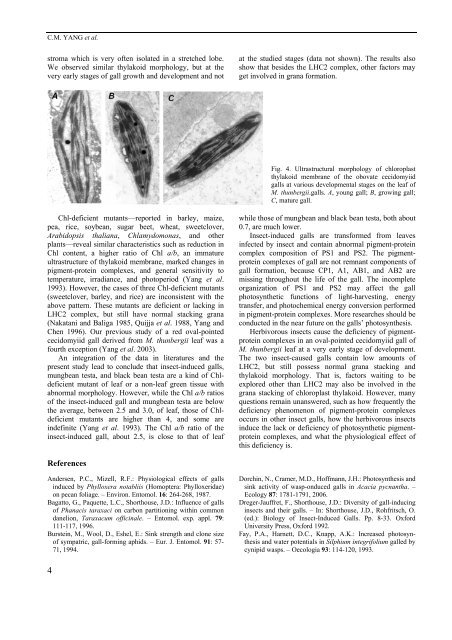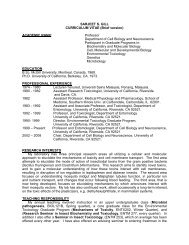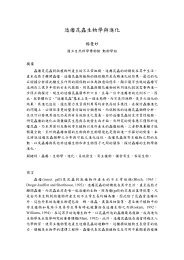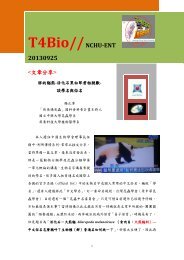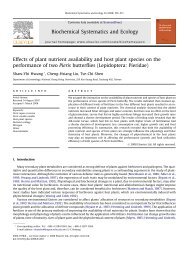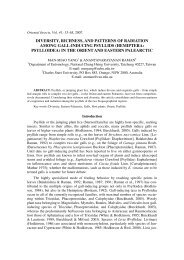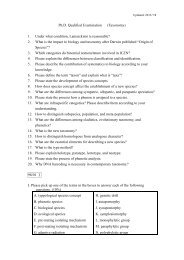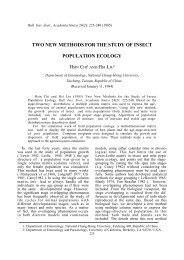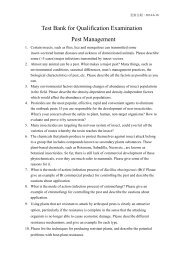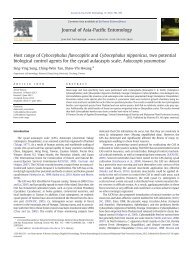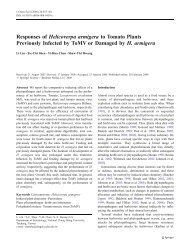Life time deficiency of photosynthetic pigment-protein complexes ...
Life time deficiency of photosynthetic pigment-protein complexes ...
Life time deficiency of photosynthetic pigment-protein complexes ...
You also want an ePaper? Increase the reach of your titles
YUMPU automatically turns print PDFs into web optimized ePapers that Google loves.
C.M. YANG et al.stroma which is very <strong>of</strong>ten isolated in a stretched lobe.We observed similar thylakoid morphology, but at thevery early stages <strong>of</strong> gall growth and development and notat the studied stages (data not shown). The results alsoshow that besides the LHC2 complex, other factors mayget involved in grana formation.Fig. 4. Ultrastructural morphology <strong>of</strong> chloroplastthylakoid membrane <strong>of</strong> the obovate cecidomyiidgalls at various developmental stages on the leaf <strong>of</strong>M. thunbergii.galls. A, young gall; B, growing gall;C, mature gall.Chl-deficient mutants—reported in barley, maize,pea, rice, soybean, sugar beet, wheat, sweetclover,Arabidopsis thaliana, Chlamydomonas, and otherplants—reveal similar characteristics such as reduction inChl content, a higher ratio <strong>of</strong> Chl a/b, an immatureultrastructure <strong>of</strong> thylakoid membrane, marked changes in<strong>pigment</strong>-<strong>protein</strong> <strong>complexes</strong>, and general sensitivity totemperature, irradiance, and photoperiod (Yang et al.1993). However, the cases <strong>of</strong> three Chl-deficient mutants(sweetclover, barley, and rice) are inconsistent with theabove pattern. These mutants are deficient or lacking inLHC2 complex, but still have normal stacking grana(Nakatani and Baliga 1985, Quijja et al. 1988, Yang andChen 1996). Our previous study <strong>of</strong> a red oval-pointedcecidomyiid gall derived from M. thunbergii leaf was afourth exception (Yang et al. 2003).An integration <strong>of</strong> the data in literatures and thepresent study lead to conclude that insect-induced galls,mungbean testa, and black bean testa are a kind <strong>of</strong> Chldeficientmutant <strong>of</strong> leaf or a non-leaf green tissue withabnormal morphology. However, while the Chl a/b ratios<strong>of</strong> the insect-induced gall and mungbean testa are belowthe average, between 2.5 and 3.0, <strong>of</strong> leaf, those <strong>of</strong> Chldeficientmutants are higher than 4, and some areindefinite (Yang et al. 1993). The Chl a/b ratio <strong>of</strong> theinsect-induced gall, about 2.5, is close to that <strong>of</strong> leafwhile those <strong>of</strong> mungbean and black bean testa, both about0.7, are much lower.Insect-induced galls are transformed from leavesinfected by insect and contain abnormal <strong>pigment</strong>-<strong>protein</strong>complex composition <strong>of</strong> PS1 and PS2. The <strong>pigment</strong><strong>protein</strong><strong>complexes</strong> <strong>of</strong> gall are not remnant components <strong>of</strong>gall formation, because CP1, A1, AB1, and AB2 aremissing throughout the life <strong>of</strong> the gall. The incompleteorganization <strong>of</strong> PS1 and PS2 may affect the gall<strong>photosynthetic</strong> functions <strong>of</strong> light-harvesting, energytransfer, and photochemical energy conversion performedin <strong>pigment</strong>-<strong>protein</strong> <strong>complexes</strong>. More researches should beconducted in the near future on the galls’ photosynthesis.Herbivorous insects cause the <strong>deficiency</strong> <strong>of</strong> <strong>pigment</strong><strong>protein</strong><strong>complexes</strong> in an oval-pointed cecidomyiid gall <strong>of</strong>M. thunbergii leaf at a very early stage <strong>of</strong> development.The two insect-caused galls contain low amounts <strong>of</strong>LHC2, but still possess normal grana stacking andthylakoid morphology. That is, factors waiting to beexplored other than LHC2 may also be involved in thegrana stacking <strong>of</strong> chloroplast thylakoid. However, manyquestions remain unanswered, such as how frequently the<strong>deficiency</strong> phenomenon <strong>of</strong> <strong>pigment</strong>-<strong>protein</strong> <strong>complexes</strong>occurs in other insect galls, how the herbivorous insectsinduce the lack or <strong>deficiency</strong> <strong>of</strong> <strong>photosynthetic</strong> <strong>pigment</strong><strong>protein</strong><strong>complexes</strong>, and what the physiological effect <strong>of</strong>this <strong>deficiency</strong> is.ReferencesAndersen, P.C., Mizell, R.F.: Physiological effects <strong>of</strong> gallsinduced by Phylloxera notabliis (Homoptera: Phylloxeridae)on pecan foliage. – Environ. Entomol. 16: 264-268, 1987.Bagatto, G., Paquette, L.C., Shorthouse, J.D.: Influence <strong>of</strong> galls<strong>of</strong> Phanacis taraxaci on carbon partitioning within commondanelion, Taraxacum <strong>of</strong>ficinale. – Entomol. exp. appl. 79:111-117, 1996.Burstein, M., Wool, D., Eshel, E.: Sink strength and clone size<strong>of</strong> sympatric, gall-forming aphids. – Eur. J. Entomol. 91: 57-71, 1994.Dorchin, N., Cramer, M.D., H<strong>of</strong>fmann, J.H.: Photosynthesis andsink activity <strong>of</strong> wasp-onduced galls in Acacia pycnantha. –Ecology 87: 1781-1791, 2006.Dreger-Jauffret, F., Shorthouse, J.D.: Diversity <strong>of</strong> gall-inducinginsects and their galls. – In: Shorthouse, J.D., Rohfritsch, O.(ed.): Biology <strong>of</strong> Insect-Induced Galls. Pp. 8-33. OxfordUniversity Press, Oxford 1992.Fay, P.A., Harnett, D.C., Knapp, A.K.: Increased photosynthesisand water potentials in Silphium integrifolium galled bycynipid wasps. – Oecologia 93: 114-120, 1993.4


